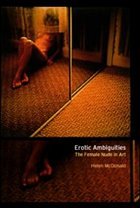Table of contents:
List of Plates Acknowledgements Introduction 1. Feminism, Ambiguity and the Ideal 2. Revisioning the Female Nude 3. Historical Ambiguity 4. Seeing Ambiguity 5. Gender Ambiguity 6. Making a Difference with Ambiguity 7. Turning Ambiguity Around 8. Hybrid Ambiguities Conclusion Notes Works Cited Index
Art is always ambiguous. When it involves the female body it can also be erotic. Erotic Ambiguities is a study of how contemporary women artists have reconceptualised the figure of the female nude. Helen McDonald shows how, over the past thirty years, artists have employed the idea of ambiguity to dismantle the exclusive, classical ideal enshrined in the figure of the nude, and how they have broadened the scope of the ideal to include differences of race, ethnicity, sexuality and disability as well as gender.
McDonald discusses the work of a wide range of women artists, including Barbara Kruger, Judy Chicago, Mary Duffy, Zoe Leonard, Tracey Moffatt, Pat Brassington and Sally Smart. She traces the shift in feminist art practices from the early challenge to partriarchal representations of the female nude to contemporary, 'postfeminist' practices, influenced by theories of performativity, queer theory and postcoloniality. McDonald argues that feminist efforts to develop a more positive representation of the female body need to be reconsidered, in the face of the resistant ambiguities and hybrid complexities of visual art in the late 1990s.
Across photography, fashion, painting and performance art, Helen McDonald shows how feminist artists have employed the idea of ambiguity to counter negative images of women and to dismantle the elusive classical ideal enshrined in the nude.
List of Plates Acknowledgements Introduction 1. Feminism, Ambiguity and the Ideal 2. Revisioning the Female Nude 3. Historical Ambiguity 4. Seeing Ambiguity 5. Gender Ambiguity 6. Making a Difference with Ambiguity 7. Turning Ambiguity Around 8. Hybrid Ambiguities Conclusion Notes Works Cited Index
Art is always ambiguous. When it involves the female body it can also be erotic. Erotic Ambiguities is a study of how contemporary women artists have reconceptualised the figure of the female nude. Helen McDonald shows how, over the past thirty years, artists have employed the idea of ambiguity to dismantle the exclusive, classical ideal enshrined in the figure of the nude, and how they have broadened the scope of the ideal to include differences of race, ethnicity, sexuality and disability as well as gender.
McDonald discusses the work of a wide range of women artists, including Barbara Kruger, Judy Chicago, Mary Duffy, Zoe Leonard, Tracey Moffatt, Pat Brassington and Sally Smart. She traces the shift in feminist art practices from the early challenge to partriarchal representations of the female nude to contemporary, 'postfeminist' practices, influenced by theories of performativity, queer theory and postcoloniality. McDonald argues that feminist efforts to develop a more positive representation of the female body need to be reconsidered, in the face of the resistant ambiguities and hybrid complexities of visual art in the late 1990s.
Across photography, fashion, painting and performance art, Helen McDonald shows how feminist artists have employed the idea of ambiguity to counter negative images of women and to dismantle the elusive classical ideal enshrined in the nude.
